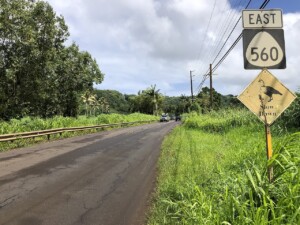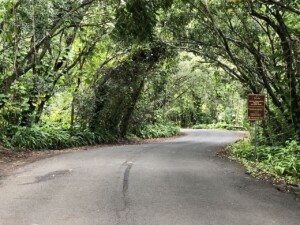Guest contributor Jonny Wichman shares his perspective on why he, as a member of the Hanalei Roads Committee, has spent years fighting to preserve Route 560, a ten-mile scenic road on the north shore of Kaua‘i.
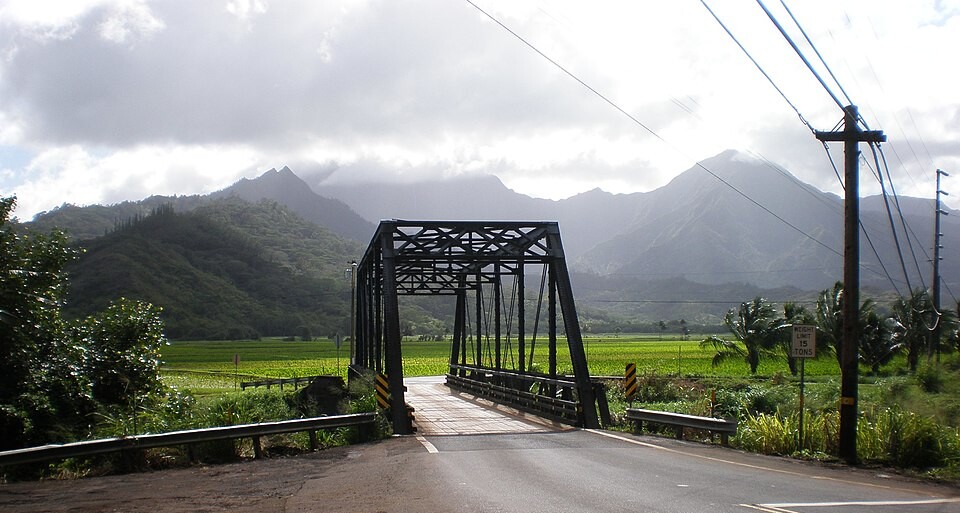
Hanalei Bridge, the gateway to the North Shore of Kauai, was originally fabricated in New York in 1912. Despite proposals to replace it as part of a two-lane freeway, it stands today, due to community opposition fueled by a desire to preserve the area’s authenticity. Photo @ Joel Bradshaw, Wikimedia Commons.
I have spent many hours discussing the preservation of Route 560 and its one-lane bridges, but I’ve never really expressed why I am fighting for Route 560’s preservation, or why so many in our community, past and present, and so many of our community organizations are committed to keeping Route 560 as slow-paced, rural and authentic to its humble beginnings as possible.
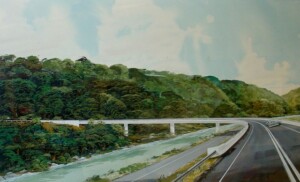
A rendering of the two-lane off-ramp proposed in the 1970s to replace Hanalei Bridge.
First, some history. It’s been a long fight. In 1974, the Hawai‘i Department of Transportation (HDOT) proposed a sweeping freeway off-ramp (HDOT rendering at right) to replace the Hanalei bridge. As Cheryl D. Soon, FAICP, (former Deputy Director for Highways, Hawai‘i HDOT) states in her paper prepared for the 2006 Preserving the Historic Road Conference in Boston, MA, “DOT developed a plan for a two lane bridge on a new alignment touching off at Princeville, efficiently bypassing the zig-zag switchbacks and descending in a straight line down towards the taro fields. But by the time they released their plan and a draft EIS in 1974, the preferred alternative was a two lane bridge along the existing alignment. Still, that plan met with immediate and strenuous opposition.”
Strenuous opposition. Why? Some, at the time, thought that this sweeping new bridge was good idea. It would move more people faster. More efficient. Less maintenance. So why did the community fight so hard against this project? If we can answer that question, we can answer the question as to why we are still fighting for our one-lane bridges, narrow culverts, and the preservation of each historic element that still exists along Route 560.
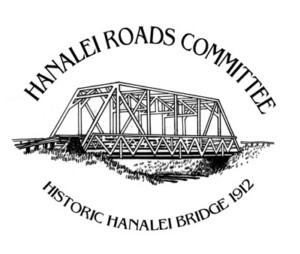 Out of this fight to save the Hanalei Bridge was born the Hanalei Roads Committee (HRC), who tasked themselves with the preservation of Route 560 (aka Kaua‘i Belt Road- North section). Aligned in this effort and with the help of the Historic Hawai‘i Foundation, the Hanalei Community Association, Hui Ho‘omalu i ka ‘Āina, Hui Maka‘ainana o Makana, Na Limu Coalition, 1000 Friends of Kaua‘i, and other community groups, and to the objection of DOT, Route 560 was nominated and accepted to the National Register of Historic Places in 2004.
Out of this fight to save the Hanalei Bridge was born the Hanalei Roads Committee (HRC), who tasked themselves with the preservation of Route 560 (aka Kaua‘i Belt Road- North section). Aligned in this effort and with the help of the Historic Hawai‘i Foundation, the Hanalei Community Association, Hui Ho‘omalu i ka ‘Āina, Hui Maka‘ainana o Makana, Na Limu Coalition, 1000 Friends of Kaua‘i, and other community groups, and to the objection of DOT, Route 560 was nominated and accepted to the National Register of Historic Places in 2004.
In 2005, HRC spearheaded local support for Senate Bill 1876. SB 1876 was a game changer for the preservation of Route 560 that directs the Department of Transportation to show flexibility in highway design, and limits liability of the state and counties in the application of flexible highway design standards. The act allows engineers and planners to consider more than just safety and efficiency when building new roads or reconstructing old roads. Factors such as the environment, scenic and historic preservation, community effects, and aesthetics are now priorities. Community sensitive designs and context-sensitive designs are encouraged. As the act says, “Hawai‘i’s rural communities are the heart and soul of the islands, reflecting the aloha spirit and natural beauty that are the essence of our State. As urbanization spreads throughout Hawai‘i, our rural communities are at risk of losing their unique identities. The imposition of uniform, conventional highway design can significantly alter and detract from the historical identities of these communities.”
As a result of SB 1876, in 2005 HRC began working with Kaua‘i DOT (KDOT) on new designs for the permanent Wainiha bridges. KDOT, led first by Kaua‘i district engineer Steve Kyono and then Ray McCormick and with the help of Federal Highways, was now free to design new one-lane bridges that captured the look and feel of the old ‘white picket fence, wooden decked’ bridges. In total, HRC and the community spent more than 12 years working with DOT and FHA to arrive at a final design for these bridges.
During this period of transition for HDOT from ‘bigger is better’ to acknowledging the benefits to the community that historic roads and slow, rural routes play, Steve Kyono used to say, “having two ears and one mouth, act accordingly.” Steve’s attitude and thinking transitioned at the same time and he eventually gave his full support and believed in the effort to preserve Route 560. We worked with Steve for many years on road issues and his leadership in community and context sensitive designs along Route 560 was groundbreaking at HDOT. Steve will tell you about his “breakthrough moment” while playing golf with his friend Pat Pfung from Federal Highways. They paused to look over Hanalei Valley and said, “This IS special. We have to save it.”
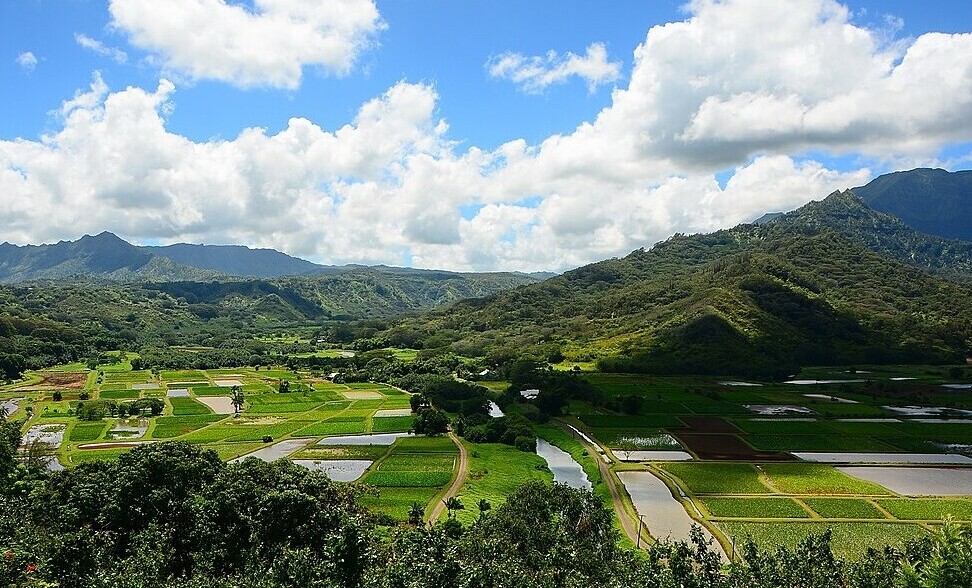
The view of Hanalei Valley from the lookout point along Route 560 @Wikimedia Commons.
“Safety, while it is a primary consideration in design, is not to be a paramount consideration; safety should be balanced with mobility, protection and enhancement of the natural environment, and preservation of community values.”
– Jones, Context Sensitive Design website FHA, 2004
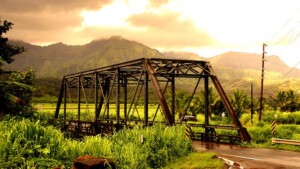
Hanalei Bridge @ Jonny Wichman.
There were countless other issues and preservation efforts made during the last five decades. In 2000, I along with members of HRC flew to Honolulu to meet with Governor Cayetano to stop a road widening project through Hanalei town. In 2003, in response to DOT’s determination that the Hanalei bridge was beyond repair, HRC invited Senator Inouye to Hanalei to see the bridge. The senator immediately recognized the significance of the bridge as the icon of the historic roadway and the guardian of our community and began working with Kyono to make the Hanalei bridge a federal monument and secure federal funds to replicate the old bridge. In 2002-2005 HRC was part of the Community Advisory Committee for the creation of the “Route 560 Historic Roadway Corridor Plan,” which continues to serve as the guiding document for our roadway.
So, here we are today. Over-tourism is finally being recognized by Hawai‘i state and county governments as being detrimental to the health and well- being of residents. Kaua‘i is near all-time high visitor counts. Traffic is backing up in Hanalei town. Too many rental cars are clogging the roads. Tourists are fighting for parking at beach parks.
Just prior to the 2018 flood, HRC reached out to DOT head Ray McCormick with an idea to help alleviate traffic at the Hanalei bridge. The plan was to design a simple, unobtrusive traffic control system that would be in character with the historic road. Ray, an admirer of old bridges and historic roadways, recognized that this was a perfect use for context sensitive design and was committed to a solution that would be in tune with the look, feel and aesthetic of the Hanalei bridge.
Then the 2018 flood happened, traffic went away, and this project was never completed. After the flood, this project was included as a stipulation of the flood repairs MOA, to partly compensate the community for the loss of the Wai‘oli, Waipa and Waikoko bridges. The “Three Ws” were determined by DOT to be too structurally weak to handle the loads required to build the new Wainiha bridges, a project DOT has committed to finishing, so these three historic bridges were replaced.
But instead of using the flexibility allowed under SB 1876 to design a system in harmony with a historic road and rural community, what was proposed was a $900,000 traffic light installation that included 2,000 ft. of new striping, 240 ft. of thermo rumble bars, 200 ft. of W-beam guardrail, two flashing approach beacons, four sets of traffic signals on poles, and twenty new warning and regulatory signs. This project would have modernized the entrance to Route 560 and completely changed the character and aesthetics of the Hanalei bridge. The community pushed back on this proposal, and rightly so. To some who have worked so hard for so many years to ensure the acceptance of context sensitive design and community sensitive design, it was a slap in the face. From the community’s perspective this project took design standards appropriate for downtown Honolulu and applied them to Route 560.
With Kiersten (Faulkner)’s guidance and leadership, we were able to remove this project from the flood repair stipulations, and KDOT shelved the project.
But, why does any of this matter? Why not modernize the bridge? Why have one-lane bridges at all? Why not just build the freeway off-ramp proposed in 1974 and be done with traffic backups?
For me, that answer is twofold. For starters, preservation is in my blood. In 1950, my Grandmother Juliet Rice Wichman stood in front of a bulldozer at Ke‘e to protect a rock wall that she knew was part of the platform of the legendary house of Lohiau. Others not familiar with the area thought it was just a rock wall. But Grandma Jule knew of its important historical significance. Growing up, she taught us that nothing was more important than the preservation of our island history and culture. She went on to create Limahuli Garden (her ‘Living Classroom’) and founded the Kaua‘i Museum in an effort to preserve our island’s culture, flora and fauna.
Secondly for me, I have seen first-hand the slow degradation of the local community due to increased tourism and traffic. Locals can no longer go to Makua to have a hukilau because there is literally nowhere for them to park. Our resources are feeling immense pressure and are being ‘loved to death’ by over-tourism and traffic. To me the answer is not to increase capacity. It is not to build bigger and faster. It is to keep the road slow and preserve what we have.
As landscape preservationist J. Timothy Keller observes, “Hanalei represents the classic tourism paradox: frequented by tourists because of its natural, historic, and scenic resources, these same resources are threatened by the presence of large numbers of visitors.”
And as Barnes Riznik wrote in Hanalei Bridge: A Catalyst for Rural Preservation, “The Hanalei Bridge continues to serve a utilitarian function as a historical engineering structure, and, it regulates traffic, keeping large busses and heavy trucks out of the Hanalei Valley. The bridge also helps define a vernacular landscape of natural beauty and slow-paced, rural lifestyle.”
For me, the bottom line is that I’m not fighting for preservation for myself. I’m doing it for those who are gone and for those yet to come. For Kapeka Chandler. For Kalehua Ham Young. For Thomas Hashimoto. For Grandma Jule. Because the next Kapeka, or Thomas or Jule, who could be born tomorrow, deserve it.
“The road from Hanalei to Ha‘ena does not just serve as a means to an end (of the road), it helps to actually define our community’s character. When one descends into Hanalei Valley and crosses the one-lane Hanalei Bridge with the sweeping vista of lo‘i kalo, one passes through a visual gateway. As the road meanders along side the river, passes through town and then embraces the cliffs of Waikoko and Lumahai before heading out to Ke‘e, the traveler is encouraged to slow down and breathe in the surrounding beauty.”
– Johanna Ventura
“The Historic Hanalei Bridge is the gateway to the north shore which alerts drivers to the slower pace and scale of the historic roadway beyond. As a visitor’s first encounter with our historic roadway, the Hanalei bridge teaches drivers to slow down, look, listen and wait their turn to cross. Drivers are alerted to the slower pace of the historic roadway they are entering and learn how to navigate a one-way rural bridge. Experience that will benefit them greatly as they navigate the six remaining one-lane bridges further along the highway”
– Jonny Wichman
Photos left to right: Views of Highway 560 (@ Wikimedia Commons); the Hanalei Pier and the author (@ Jonny Wichman). After being listed by HHF as a Most Endangered Place in 2012, the Pier was saved from demolition the following year, thanks to a “Save the Pier” campaign initiated by the The Rotary Club of Hanalei Bay. The pier is listed on the National Register of Historic Places.
Editor’s Note: Jonny Wichman originally composed this personal statement in an email addressed to Larry Dill, District Engineer, KDOT with the additional reference materials. Wichman gave Historic Hawai‘i Foundation permission to publish it.
Further reading:
Context Sensitive Design, Flexible Standards and Preserving Rural Roads and Cultural Landscapes: Including the Case of Saving Kuhio Highway on Kaua‘i, Hawai‘i by Cheryl D. Soon, FAICP. Great reading, especially the chapter entitled, “History of the Community’s Efforts Against Inappropriate Development and Change.”
Hanalei Bridge: A Catalyst for Preservation by Barnes Riznik, The Public Historian, Summer 1989, Vol. 11, No. 3 (Summer, 1989), pp. 45-67.
Containing Tourism in Historic Hanalei by Robert Z. Melnick and J. Timothy Keller, Landscape Architecture Magazine, July/August 1987, Vol. 77, No. 4, (July/August 1987) pp. 46-51.
Act 185 (2005) – the bill that gives HDOT leeway for flexible and context sensitive highway design
Kūhiō Highway Route 560 Historic Corridor Plan
Kaua‘i Emergency Floor Repairs and Cleanup Memorandum of Agreement (2018)
Emergency Repairs to Kaua‘i Belt Road Will Retain and Strengthen Wai‘oli Bridge, Demolish Two Other Historic Bridges, Historic Hawai‘i News, September 2018.
Amendment of the National Register of Historic Places Registration for Kaua‘i Belt Road
Kauai Residents Unload About Overtourism At DOT Meeting, Honolulu Civil Beat, June 10, 2022.
Regenerative Tourism in The National Spotlight, Hawai‘i Dept. of Land and Natural Resources news release, July 13, 2022.


